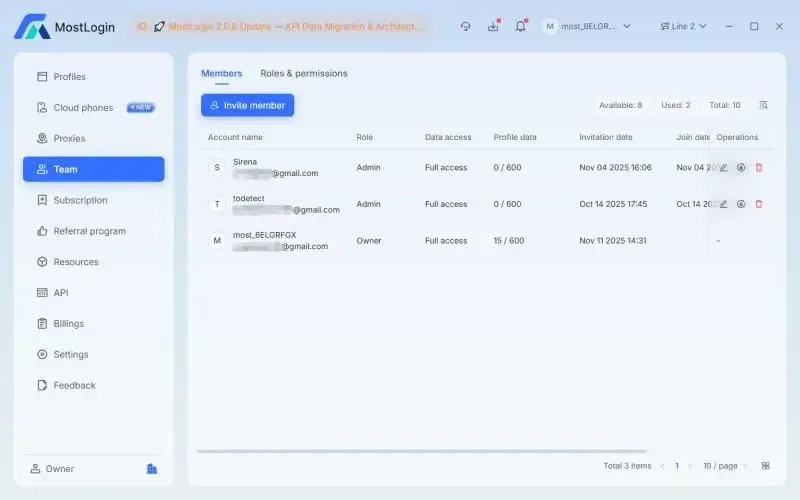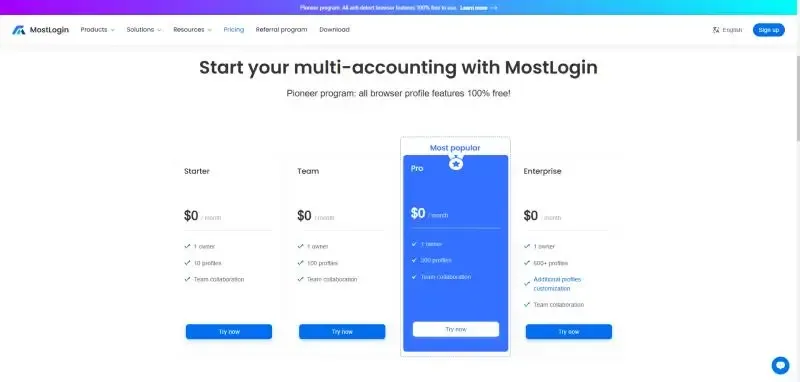Why Use Anti-Detection Tools for Account Management? Key Advantages of Fingerprint Browsers


Anyone engaged in cross-border e-commerce, social media marketing, or advertising knows that one account is often not enough. To target different users and markets, you need to implement different content and marketing strategies, ideally dedicating each account to a specific direction, which is why multi-account management is necessary.
However, major platforms (such as Facebook, Instagram, LinkedIn, etc.) continuously improve their risk control systems, using signals like user login IPs, browser fingerprints, hardware information, and cookies to determine whether multiple accounts are operated by the same person. Once recognized as "linked accounts," this can result in content restrictions or account bans.
The operational cost for each account can be high initially. To save time and manpower while avoiding multi-account linkage risks, more users are turning to anti-detection tools. The most representative of these is the fingerprint browser.
What is an Anti-Detection Tool?
Simply put, an anti-detection tool is designed for managing and operating multiple online accounts. Its core purpose is to prevent different accounts from being detected as linked by platforms, thereby reducing the risk of bans, restrictions, or account suspensions.
Why Use an Anti-Detection Tool?
To maintain fair operations, social media platforms often use "linkage detection" technology to identify whether one person is operating multiple accounts.
This detection combines multiple data points:
1. IP address: Frequent logins from the same IP across multiple accounts are the most “critical” linkage signal.
2. Hardware information: Operating system version, CPU cores, RAM size, etc., can also reveal linkage signals.
3. Browser fingerprint: Language, fonts, plugins, timezone, Canvas fingerprint, WebGL fingerprint, etc. The combination of these parameters can form a nearly unique “online identity.”
Once a platform detects account linkage based on these signals, the consequences may include:
1. Account restriction: Content is only visible to followers or not recommended, resulting in low exposure.
2. Bans or mass suspensions: All linked accounts may be deactivated, and funds frozen.
3. Wasted costs: Previously invested time, manpower, and money are lost.
Therefore, the true purpose of anti-detection is to create an independent, clean, and highly realistic network and device environment for each account, making the platform's risk control system believe these accounts are operated by different real users, avoiding linkage risks.
Core Advantages of Fingerprint Browsers
Fingerprint browsers are the most widely used anti-detection tools on the market. Compared to ordinary proxies or multi-instance software, they not only change IPs but also comprehensively disguise fingerprint information, creating an independent environment that platforms cannot detect.
The login and usage process of an account is essentially a fingerprint comparison by the platform. Websites collect various hidden information from browsers, such as:
1. User-Agent: Displays your browser type and operating system version;
2. WebRTC settings: May reveal your real IP or network interfaces;
3. Canvas & WebGL fingerprint: Reflects GPU rendering characteristics and is one of the most identifiable parameters;
4. Voice, timezone, and geolocation: Determines where the account “resides” geographically;
5. Cookies & local storage isolation: Prevents account data from mixing or being recognized as operated by the same user.
Fingerprint browsers deeply disguise and isolate these data points, creating a fully independent browser environment for each account. To the platform, it appears that all account activity is real user behavior, mitigating linkage risks and bans.
Cross-border e-commerce sellers can safely manage multiple stores using this technology, and social media marketing teams can run multiple accounts stably without worrying about restrictions or bans.
MostLogin: Professional Anti-Detection Solution
Among the many fingerprint browser tools available, MostLogin stands out for its powerful environment isolation and flexible team collaboration features, making it the choice for cross-border e-commerce, social media marketing, affiliate marketing, advertising, and more.

Powerful Custom Browser Fingerprint Configuration
MostLogin allows users to configure unique fingerprint parameters for each browser environment, including operating system, browser version, language, timezone, resolution, Canvas fingerprint, WebRTC, and more, ensuring each account has a unique “device identity” to prevent platform linkage detection.
Proxy Configuration
MostLogin supports HTTP, HTTPS, SOCKS5, and other proxy types. When creating a profile, each browser environment can be assigned a unique IP address, ensuring all accounts operate independently.
Team Collaboration
For businesses or small teams, MostLogin offers efficient team management features, including permission assignment and environment sharing. Admins can assign specific browser environments to different users while controlling their access rights, ensuring data security and smooth collaboration.

Completely Free
MostLogin Fingerprint Browser is completely free. Whether you want to log into multiple accounts or use RPA automation, you can download and create profiles directly, generating thousands of unique browser environments that do not interfere with each other.

Applications of Fingerprint Browsers
Cross-Border E-Commerce
The same computer can manage multiple accounts on Amazon, eBay, Shopee, etc., avoiding “same device” linkage bans. Each store can have unique IPs and fingerprint data, ensuring the platform recognizes the user as a real seller and reducing account risks.
Social Media Marketing
Manage multiple TikTok, Instagram, Facebook accounts simultaneously, running content matrix campaigns. Independent fingerprint and residential IP make the platform treat accounts as genuine users from multiple countries, improving efficiency and reducing costs.
Web Scraping
When scraping e-commerce prices or reviews, each scraper window automatically switches fingerprints and proxies, preventing the target site from detecting the same device and lowering the risk of bans.
Conclusion
With the continuous upgrade of platform risk control systems, multi-account management is no longer just about efficiency—it affects whether your business can operate steadily. Choosing a fingerprint browser like MostLogin ensures each account has a safe, independent operating environment, avoiding linkage bans.
FAQ
Is using a fingerprint browser safer?
Yes. Fingerprint browsers deeply disguise fingerprint information, bind independent proxy IPs, and isolate account data, fundamentally reducing the risk of platform detection of “linked accounts.”
What’s the difference between a fingerprint browser and a regular browser?
Regular browsers cannot isolate account information; logging into multiple accounts on the same device can be detected by platforms. Fingerprint browsers allow customizing browser fingerprints (e.g., resolution, OS version, timezone, Canvas fingerprint) and isolate cookies and cache, simulating independent environments for each account.
How can teams share browser environments without data leaks?
MostLogin provides a three-tier system of "member-role-environment." Admins can assign specific permissions, allowing employees to open but not modify or export environments. All operations are logged in the cloud, with audit support.
🚀 Best Anti-Detection Browser – MostLogin
MostLogin anti-detection browser helps users solve high-frequency issues such as multi-account management, environment isolation, and account risk control.
For operational questions, please refer to the official help documentation


